| ATTIC HEAT ... Attic Ventilation
Homeowners beware!
by If your home is over twenty years old, a 98% probability exists that your attic has
excessive heat, an indication of unsatisfactory roof ventilation, allowing
build-up of excessive attic moisture. Why is excessive attic moisture a problem? Excessive attic moisture
leads to more serious problems, including
delamination of the roof sheathing, wood rot of structural members, failure of the insulation, leading to higher air
conditioning and heating bills, blistering and peeling paint, both interior and exterior, and the development of mold
growth, causing serious health problems, disguised as asthma, allergies, colds and sinus conditions.
And, in snow climates, excessive attic heat causes ice damming, leading to serious interior water
leakage and subsequent damage, often blamed on the roofer, but who is seldom to blame. The good news... |
|
| These are two very important questions that must be asked of and answered by every construction design, whether it is for new construction, for additions, or for renovations. Without excessive heat, there are no moisture condensation problems, no health related issues, and no ice dams! |
| Excessive attic heat may unintentionally be created by: |
1. The Architect |
| Air flow reduces heat and is easily explained, using a catsup bottle as an example. When you open a new bottle of catsup and turn it over, and the catsup does not come out, do you know why? In order for the catsup to exit the bottle, air must enter the bottle. The same is true for your attic. In order for excessive heat to exit the attic, inlet or make-up air must be able to enter the attic. Having "only" inlet vents, or having "only" outlet vents is as good as having "no vents" at all! You must have both, inlet and outlet vents and in a balanced proportion, too. |
| The following are pictorial examples of some ways excessive heat enters the attic space and some reasons why that unwanted heat can not exit that attic space, the ultimate enemy of a healthy home. |
 Architects and Designers are constantly trying to create aesthetically pleasing new homes.
However, aesthetic roof designs are not always compatible with a variety
of climates. In fact, complex roof lines create some distinct and intrinsic problems regarding
dissipation of excessive attic heat. This newly constructed property has excessive attic heat and several climate-related design
problems, including the channeling of snow and ice from two portions of the large, main roof, down
and onto the lower roof area, entrapping snow and ice between the sidewalls of the main house
and the dormer. Reduction of adequate soffit inlet ventilation air flow allowed excessive heat build-up, creating ice dams.
The spikes of white snow along the rake, outside the living area, are classic snow-melt patterns indicative of unsatisfactory attic
ventilation that when seen are signs of excessive heat. If snow melt had been the result of heat from the sun, all of the roof
would have been be clear, and without any white spikes. The "rule-of-thumb" is that attic air with functional ventilation should never
be more than 15 degrees hotter than the outside air. If it is hotter, that excessive heat must be addressed.
Architects and Designers are constantly trying to create aesthetically pleasing new homes.
However, aesthetic roof designs are not always compatible with a variety
of climates. In fact, complex roof lines create some distinct and intrinsic problems regarding
dissipation of excessive attic heat. This newly constructed property has excessive attic heat and several climate-related design
problems, including the channeling of snow and ice from two portions of the large, main roof, down
and onto the lower roof area, entrapping snow and ice between the sidewalls of the main house
and the dormer. Reduction of adequate soffit inlet ventilation air flow allowed excessive heat build-up, creating ice dams.
The spikes of white snow along the rake, outside the living area, are classic snow-melt patterns indicative of unsatisfactory attic
ventilation that when seen are signs of excessive heat. If snow melt had been the result of heat from the sun, all of the roof
would have been be clear, and without any white spikes. The "rule-of-thumb" is that attic air with functional ventilation should never
be more than 15 degrees hotter than the outside air. If it is hotter, that excessive heat must be addressed.
|
 The General Contractor often creates excessive attic heat. Standing in the attic, looking down into the open space
around the living room fireplace, heat abounds. Other heat problems exist here, too. Look closely at the gray area
in the photograph, which is the back of the drywalled walls. No insulation! Therefore,
even when the fireplace is not in use, excessive heat is still entering the attic through
the uninsulated walls. This home will have huge utility costs both for heating and for cooling.
The General Contractor often creates excessive attic heat. Standing in the attic, looking down into the open space
around the living room fireplace, heat abounds. Other heat problems exist here, too. Look closely at the gray area
in the photograph, which is the back of the drywalled walls. No insulation! Therefore,
even when the fireplace is not in use, excessive heat is still entering the attic through
the uninsulated walls. This home will have huge utility costs both for heating and for cooling.
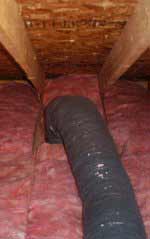 Insulation is designed to keep heat within the living space in cold climates and heat above the cooled living space in warm climates.
The pink insulation was not installed according to specifications, and was blocking the soffit inlet vents. Soffit vent protectors
were not utilized and should have been installed to help avoid insulation from blocking the soffit vents. 12" of insulation, creating
an R-38, is optimal. Remember, only have one vapor barrier and install it facing down to the heated surface. If additional layers of
insulation are needed to attain 12", use either unfaced insulation or blown-in insulation.
Insulation is designed to keep heat within the living space in cold climates and heat above the cooled living space in warm climates.
The pink insulation was not installed according to specifications, and was blocking the soffit inlet vents. Soffit vent protectors
were not utilized and should have been installed to help avoid insulation from blocking the soffit vents. 12" of insulation, creating
an R-38, is optimal. Remember, only have one vapor barrier and install it facing down to the heated surface. If additional layers of
insulation are needed to attain 12", use either unfaced insulation or blown-in insulation.
 All sidewalls facing an unheated surface must be insulated, with the vapor barrier facing the heated surface. Attic air space
should be considered unheated space. Thus, all walls adjoining that space must be insulated to help reduce excessive attic heat.
Also, a door leading to an unheated attic space must be addressed and trimmed as if it were an outside door, complete with saddle
and weatherstripping. This newly constructed home had excessive ice dam leakage and interior water damage, with the owners demanding that
the roofer shovel the snow off of the roof, which he did, at risk of life and limb! Heat, not the roofer, was the problem.
All sidewalls facing an unheated surface must be insulated, with the vapor barrier facing the heated surface. Attic air space
should be considered unheated space. Thus, all walls adjoining that space must be insulated to help reduce excessive attic heat.
Also, a door leading to an unheated attic space must be addressed and trimmed as if it were an outside door, complete with saddle
and weatherstripping. This newly constructed home had excessive ice dam leakage and interior water damage, with the owners demanding that
the roofer shovel the snow off of the roof, which he did, at risk of life and limb! Heat, not the roofer, was the problem.
|
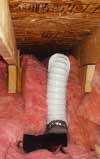 Another common, but unsatisfactory practice, allowing heat to enter the attic, involves installing the bathroom exhaust vent duct into
the soffit vents, rather than correctly installing this duct to an outlet vent. Soffit vents are inlet vents, not outlet vents!
Everything that exits the house at a soffit vent immediately re-enters the house in the attic space, because that is what soffit vents do,
they bring in outside air flow. Not only will this add heat, but it will also add humidity and moisture to the attic, defeating the very
reason for installing the bathroom fan in the first place. This is a Real Problem! Even a home with functional attic ventilation
can now develop molds on the roof sheathing cavities above these unsatisfactory ducts. Now you have no air flow, added heat and added
humidity in a dark, moist environment. Not good!
Another common, but unsatisfactory practice, allowing heat to enter the attic, involves installing the bathroom exhaust vent duct into
the soffit vents, rather than correctly installing this duct to an outlet vent. Soffit vents are inlet vents, not outlet vents!
Everything that exits the house at a soffit vent immediately re-enters the house in the attic space, because that is what soffit vents do,
they bring in outside air flow. Not only will this add heat, but it will also add humidity and moisture to the attic, defeating the very
reason for installing the bathroom fan in the first place. This is a Real Problem! Even a home with functional attic ventilation
can now develop molds on the roof sheathing cavities above these unsatisfactory ducts. Now you have no air flow, added heat and added
humidity in a dark, moist environment. Not good!
 Compounding excessive heat problems even further, when this addition was installed, the
entire house was re-sided. However, the original wood-covered soffit overhangs were never removed
before installing the new, perforated soffit vents, thus eliminating all inlet air flow to the
attic, necessary for a healthy home!
Compounding excessive heat problems even further, when this addition was installed, the
entire house was re-sided. However, the original wood-covered soffit overhangs were never removed
before installing the new, perforated soffit vents, thus eliminating all inlet air flow to the
attic, necessary for a healthy home!
|
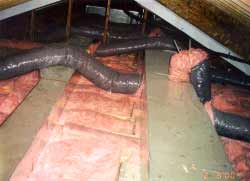 The Heating, Ventilating and Air Conditioning Contractor had limited space to install the h.v.a.c. system, so he
installed it within the low slope roof's attic space. Big mistake! The more shallow the roof pitch, the greater the risk of
ice dams. Aside from the very difficult access for monthly maintenance, the low sloped roof eliminated
buffering air spaces between the furnace and the roof, further enhancing heat build-up, leading to snow melt and ice damming, not
to mention eventual pre-mature aging the roofing materials. The silver image at the top, center of
this photograph is a full-sized, natural gas-fired, forced hot air furnace. Excessive flex
ducts allow additional unwanted heat to enter the attic space. The bottom, center of this
photograph reveals a "typical" gap in the pink insulation, allowing excessive
heat to enter the attic.
The Heating, Ventilating and Air Conditioning Contractor had limited space to install the h.v.a.c. system, so he
installed it within the low slope roof's attic space. Big mistake! The more shallow the roof pitch, the greater the risk of
ice dams. Aside from the very difficult access for monthly maintenance, the low sloped roof eliminated
buffering air spaces between the furnace and the roof, further enhancing heat build-up, leading to snow melt and ice damming, not
to mention eventual pre-mature aging the roofing materials. The silver image at the top, center of
this photograph is a full-sized, natural gas-fired, forced hot air furnace. Excessive flex
ducts allow additional unwanted heat to enter the attic space. The bottom, center of this
photograph reveals a "typical" gap in the pink insulation, allowing excessive
heat to enter the attic.
|
 An Electrician added excessive heat by installing a "standard" recessed lighting fixture in the master bedroom ceiling
for use as a reading light over the bed. However, when the light fixture was utilized with snow cover on the roof, additional heat
was generated in very close proximity to the low sloped roof, causing pre-mature ice melt and ultimately an ice dam.
This roofer did not stand a chance!
An Electrician added excessive heat by installing a "standard" recessed lighting fixture in the master bedroom ceiling
for use as a reading light over the bed. However, when the light fixture was utilized with snow cover on the roof, additional heat
was generated in very close proximity to the low sloped roof, causing pre-mature ice melt and ultimately an ice dam.
This roofer did not stand a chance!
|
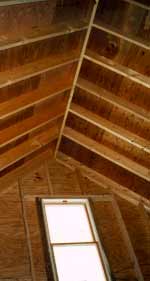 Roofers, caution, you must properly cut away the required amount of roof sheathing before installing
ridge vent systems, which require almost a 2" opening on each side of the ridge board for the proper amount of net free-air vent space.
Other portions of this roof's ridge vent had both felt paper and
shingle materials covering the opening, thus reducing exiting net free-air flow.
Without exits for attic air, heat builds up, melting snow, creating ice dams and causing many other problems, too.
Roofers, caution, you must properly cut away the required amount of roof sheathing before installing
ridge vent systems, which require almost a 2" opening on each side of the ridge board for the proper amount of net free-air vent space.
Other portions of this roof's ridge vent had both felt paper and
shingle materials covering the opening, thus reducing exiting net free-air flow.
Without exits for attic air, heat builds up, melting snow, creating ice dams and causing many other problems, too.
|
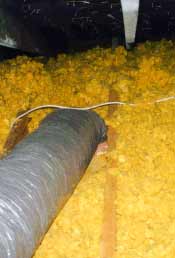 Homeowners often create the perfect medium for mold growth - dark, moist, heated space. New evidence suggests serious
health hazards associated with breathing in the black mold spores, found in 80% of the homes I have inspected over the years, both
new and old! The black area above the yellow insulation is not black due to a lack of light. It is black due to
heavy black mold growth! My own doctor called me to inspect the "dripping wet attic" of his brand new home. Concerned
about low humidity, he turned the central humidifier to maximum. Unfortunately, his builder did not install proper ventilation, either.
The consequences were dripping wet roof sheathing, covered with heavy black mold, for which his family was allergic! If left unchanged,
his new home would have sustained delamination of the plywood roof sheathing, wood rot of structural members, peeling and blistering
paint, failure of the insulation, and a completely unhealthy home! Remember, just because you are not allergic to molds today does not
insure that you will not be allergic to molds tomorrow! Oh, if you have gable or roof vents, please don't cover them with plastic.
That is the equivalent to smothering your home!
Homeowners often create the perfect medium for mold growth - dark, moist, heated space. New evidence suggests serious
health hazards associated with breathing in the black mold spores, found in 80% of the homes I have inspected over the years, both
new and old! The black area above the yellow insulation is not black due to a lack of light. It is black due to
heavy black mold growth! My own doctor called me to inspect the "dripping wet attic" of his brand new home. Concerned
about low humidity, he turned the central humidifier to maximum. Unfortunately, his builder did not install proper ventilation, either.
The consequences were dripping wet roof sheathing, covered with heavy black mold, for which his family was allergic! If left unchanged,
his new home would have sustained delamination of the plywood roof sheathing, wood rot of structural members, peeling and blistering
paint, failure of the insulation, and a completely unhealthy home! Remember, just because you are not allergic to molds today does not
insure that you will not be allergic to molds tomorrow! Oh, if you have gable or roof vents, please don't cover them with plastic.
That is the equivalent to smothering your home!
|
|
Now you know things not to do, so let's discuss
things to do about excessive heat.
First, confirmed that every roof has continuous soffit inlet vents that are fully open and functioning. If your home was designed and built in the 1950's, without any soffit overhangs, making the installation of conventional soffit inlet vents impossible, there is new hope. New products now provide inlet air at eaves without overhangs, by bringing the air in from behind the gutters, and under the shingles and sheathing. |
| Second, confirm that every roof has functional outlet vents, (9" roof vents, or gable end vents, or ridge vents). Since excessive heat rises to the peak of the roof, the best outlet vent is a ridge vent. |
|
Third, you must eliminate excessive heat sources from entering your attic, as discussed above. If your home has experienced any of the above scenarios, start now to correct these problems before they become major problems. Remember..."A stitch in time saves nine." |
Summary:
Licensed Contractor Please contact us at:
Phone: (570) 262-9236
|
